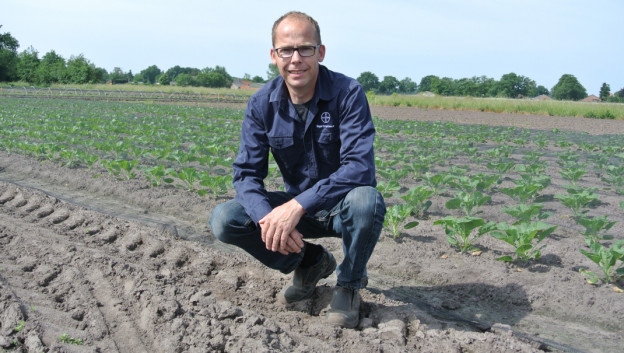Bayer CropScience
Brought to you by Bayer CropScience
Today 10:30 am
“A great, insidious and often underestimated danger that claims new victims every year.” With these words, Mark Ermers of Cebeco Agro outlines the ever-increasing problems with Fusarium in onions. In order to suppress this soil disease as much as possible, it must be tackled in all possible ways – integrated – according to the onion specialist.
As far as he is concerned, most of the possibilities for this lie at the ‘front’ of the cultivation, such as a sufficiently large rotation, a healthy, resistant soil and the right choice of varieties. In addition, growers also have the option of carrying out a soil application with Rudis prior to sowing.
How big is the Fusarium problem in the Netherlands?
“Fusarium has become the most harmful soil disease in onions in recent years. The fungus survives in the soil for at least fifteen years and mainly shows itself under less favorable growing conditions, often first on headlands and in spray tracks.”
“From research by Uireka, we now know that Fusarium oxysporium f. sp.cepea in particular is the main culprit. The majority of all contamination is caused by this species, as has been established in various tests. With a bioassay developed within Uireka via TaqMan detection , the cepea variant can be detected at an early stage on plant material and in soil samples. Moreover, with this biotest you can also quantify the fungus, so that you can predict – together with the field data – what the fusarium pressure will be and what measures you should take as grower can take.”
That sounds like a rather revolutionary development…
“It is! It even seems possible to include the biotest in regular soil sampling in the future. That would be a huge step forward in predicting the Fusarium fungus at an early stage and taking measures against it. We looked within Uireka to see whether anything could be said about damage thresholds and which host plants increase or decrease the fungus. And we make progress there every year. In that respect, you can safely call the Uireka research groundbreaking.”
What measures can you take as a grower against Fusarium?
“First of all, it is important to realize that Fusarium not only negatively influence the quality and quantity of the next harvest, but that they also increasingly affect the continuity of the cultivation as a whole. Measures must therefore reach beyond the next cultivation and also secure harvests after three or four rotations.”
“I therefore see the most important measures against Fusarium mainly at the ‘front’ of the cultivation. In other words: the right choice of plot, ample crop rotation (better 1-to-8 instead of 1-to-6), good farm hygiene and a smart choice of varieties. As a grower you have to work with this in any case.”
Onion growers also have the option of carrying out a soil treatment with Rudis against Fusarium before sowing. What can they expect from it?
The big plus of Raw is that you can secure an important part of the proceeds with it. Multi-year trials have shown that with an average Fusarium infection, approximately 30% fewer onions are affected after application of the product. In other words: when using Rudis, an average of 30% more salable product remains. In heavily contaminated plots, the damage caused by Fusarium is up to 20% lower. It is therefore very soon profitable to use Rudis on slightly contaminated plots.”
Does Rudis work just as well on white rot as on Fusarium?
“Yes, about the same percentage increase in the number of healthy onions applies to both diseases. In practice, Rudis is often referred to as a ‘Fusarium fighter’, but it certainly works just as well against white rot. And perhaps good to emphasize: of Raw you do not remove the problems with white rot and Fusarium. Preventive measures to prevent these diseases should really be number 1!”
Finally: are there any aspects you should take into account when using Rudis?
“It is important to avoid direct contact with onion seed. The active substance – prothioconazole – can be phytotoxic for the seed. It is therefore preferable to carry out the soil application before the last tillage, so that the agent is optimally distributed through the top layer .”



